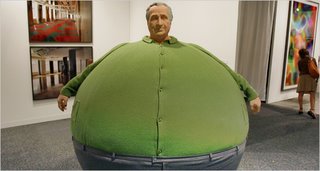More Than You Can See: Storm of Art Engulfs Miami, The NY Times

It’s Baselmania week in Miami: the week the art world gets high on art fairs, its current drug of choice. This year there are said to be 13 additional fairs grouped around the mother ship, Art Basel Miami Beach, now in its fifth year. Once, an art fair was a concentrated event; more and more it is a catalyst for diffuse, ancillary, tag-along, glamour-by-association shop-a-thons. There are spin-off art fairs and design shows, museum openings, gallery exhibitions, private collection viewings, book signings, product introductions, fashion events and sundry art parades — all unfolding amid a good deal of social to-ing and fro-ing, seeing and being seen at parties, dinners, receptions and brunches.
Art Basel Miami Beach alone now offers more than any one person can see: in addition to nearly 180 exhibitors in the Miami Beach Convention Center, there are panels, lectures, a video lounge, a sound-art lounge, artist projects and Art Positions, the minifair held in containers on the beach. So in a way you’re back at square one, looking at the art. Seeing what I could — some of Basel Miami Beach and Positions, much of the New Art Dealers Alliance fair known as NADA, assorted museum exhibitions, some private collection shows — I had a fabulous time.
It is probably de rigueur to note, at this point, the insatiable appetite for art at fairs like this: the mindless buying frenzy, the herdlike pursuit of certain names, the trophy hunters with hedge fund money, the 100 museum-led groups that have descended on Miami this week, according to The Art Newspaper (which swings into a daily publication schedule for this fair). But the most valuable commodity at an art fair is information, and that is available to anyone.
The information has a particular intensity here. Unlike London, where the major museums are setting their exhibition clocks to Frieze Art Fair time, or New York, where the art machine is big enough to swallow almost any art fair whole, Miami offers what might be called a level playing field for different viewing circumstances: i.e., fairs, museums, the private collector/alternative spaces and a few other ventures. All contribute equally to the flow of information.
All sorts of new stuff fills the NADA fair, which occupies a sprawling white stucco building in the Wynwood section of Miami. At the London dealer Dicksmith’s booth, for example, the Japanese-born video artist Meiro Koizumi has a short video titled “Amazing Grace,” in which his face serves as whipping post, lead character and stage set all at once. For something more restrained, try Emily Wardill’s equally engaging, if more abstract, films at Jonathan Viner, another London dealer.
Kazok Hall, from Vienna, has a beautiful oversize rag rug, with fringe as long as hair extensions. It was made by Fabrics Interseason, a fashion collaborative that converts unsold clothes to rugs at the end of each season. Yet at Leo Koenig, a big, gaudy new painting by Peter Saul, now in his 70s, is in full cry.
At Art Basel Miami Beach the outer ring of the convention center, called Art Nova, is devoted to younger galleries and feels livelier than NADA. One of the dealers there, Catriona Jeffries from Vancouver, is introducing the artist Judy Radul with “Five Pieces of Relation,” an elaborate yet tight multimedia sculpture installation. The work sets the mind to thinking about the souls of animals, employing a teleprompter, a live camera, several small monitors and music.
All along the Art Nova pipeline, you run into pockets of resistance to the art world’s consumer culture. At the Maccarone booth you enter a small room and see (along with the artist himself) Anthony Burdin’s latest hallucinatory excursion into video, sound and the desert landscape. At Susanne Vielmetter, Rodney McMillian bucks the system with 15 identical photographs of a rather beat-up plaster bust honoring some forgotten businessman. As Ms. Vielmetter explained, quite happily, she expects to confirm Mr. McMillian’s theory that people won’t buy what is clearly plentiful.
Read here the complete article.

0 Comments:
Post a Comment
<< Home